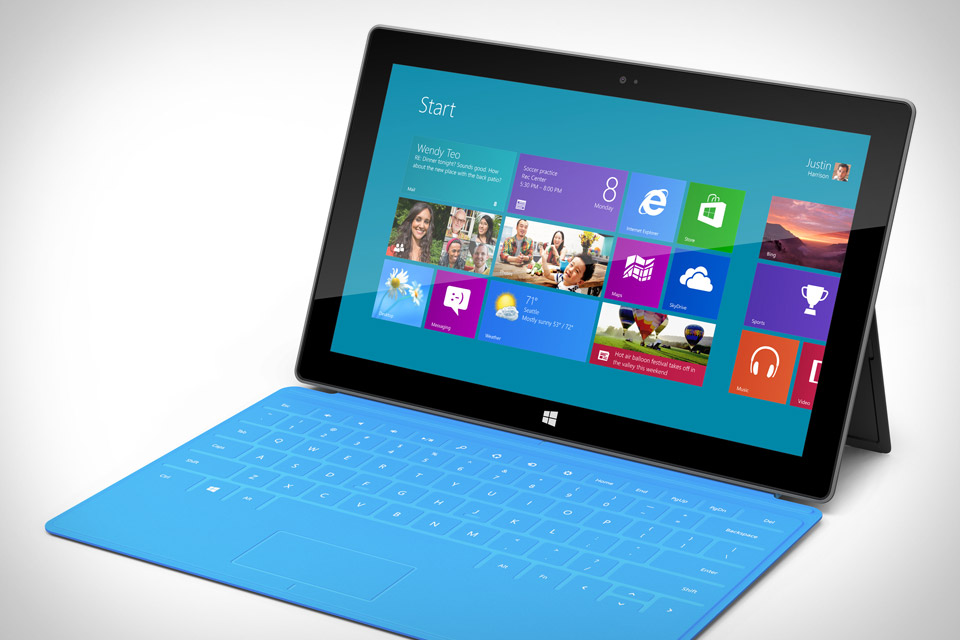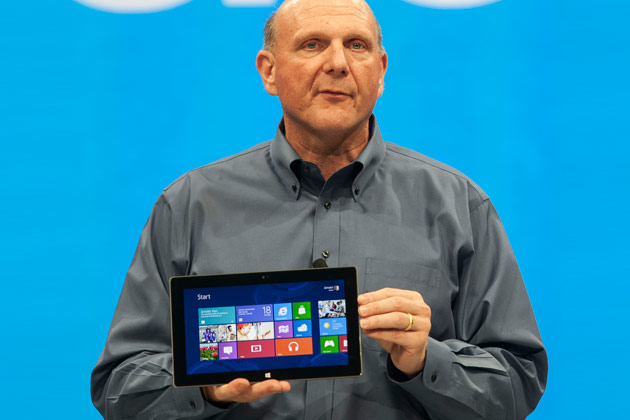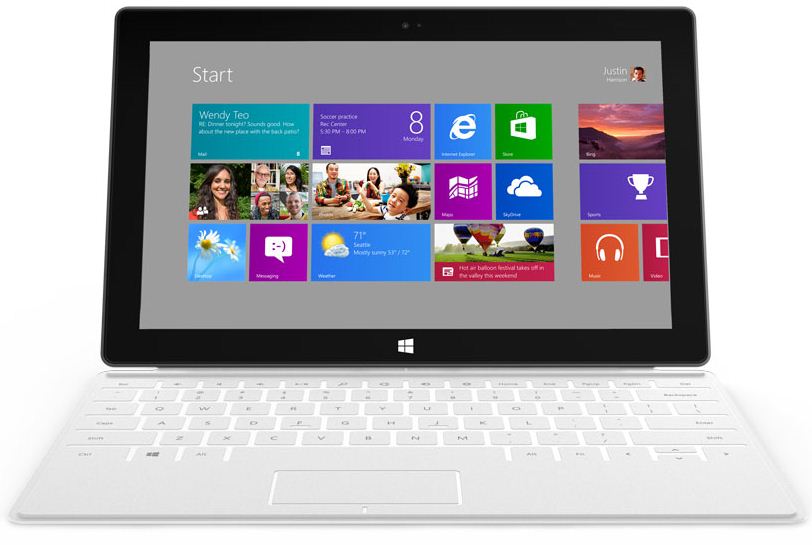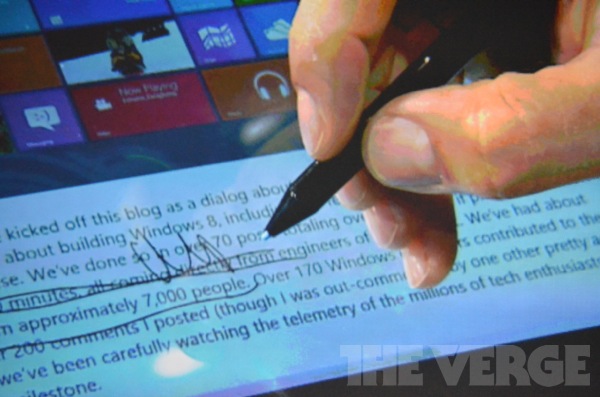Microsoft’s ‘Surface’ Tablet Is A Bigger Rival To The iPad Than You Think

Having been granted a favourable early look at Windows 8 late last year, we came away with high hopes for the future of Windows. We enthused how Microsoft’s latest operating system was “an OS for the age of the tablet PC,” and how “if Windows 7 was the admirable yet flawed first chapter for Microsoft to claw back some of Apple’s dominance in the market, this [was] the climactic body of the fight.”
Windows 8 with its sleek, free-flowing menus, drag-and-drop multi tasking and touch-friendly Metro interface is unmistakeably built from the ground-up for tablet PCs. With the unveiling by Microsoft at its shrouded-in-mystery event just two nights ago of its own Windows 8-donning ‘Surface’ tablet, the tech giant’s strategy becomes ever clearer. The message was simple: take on Apple at its own game by building a tablet not restricted to the consumption of media.
As the company’s chief executive Steve Ballmer put it, “the Surface is a PC, the Surface is a tablet and the Surface is something new that we think people will really love.” The Surface also promises to be a significantly more potent rival to the iPad than you otherwise might think. From what we’ve seen so far of the device, head honcho Ballmer’s belief appears more grounded in reality than Windows 8 sceptics would have you believe.
the Surface is something new that we think people will really love.” The Surface also promises to be a significantly more potent rival to the iPad than you otherwise might think. From what we’ve seen so far of the device, head honcho Ballmer’s belief appears more grounded in reality than Windows 8 sceptics would have you believe.
Because without relying on competitor manufacturers to produce a tablet in which Windows 8 can be star of the show, Microsoft has gone its own way. In its eyes (and rightly so), if you want something done right, do it yourself. So be it, Microsoft has already dubbed its Surface range of tablets as “companion hardware” to Windows 8.
In The Blue Corner...
I can only speak for myself when I say I’ve always had a reluctance to opt for the iPad, even as the Apple hype machine gears into over-drive in the run-up to the next greatest, ‘revolutionary’ (or indeed, ‘resolutionary’) generation. Because while I can entirely understand the want for Apple’s tablet –- after all, it is a superbly well-made product with enough tech sheen, power and resourcefulness to be a genuinely strong addition to any line-up of gadgets –- between owning a smartphone, a desktop PC and a more slim-line laptop, I simply haven't yet stumbled across a need for one.
And it’s here where I believe Microsoft now has a tremendous opportunity to not only claw back some of the market already cornered by Apple and Android tablets, but even over-take them both by winning over some of those, like myself, previously abject to owning a tablet PC of its kind.
So far showing off two variants in what is sure to be a long-running family of tablets; the Surface is also a clear convergence between the Windows experience, the consumer-friendly simplicity of tablet personal computing and a full-fledged PC in its own right.
Likely to be aimed towards home users; the first, an ARM-based Windows RT tablet comes in at just 9.3mm thick, weighs 676 grams, features Nvidia’s Tegra processor and will ship in both 32Gb and 64Gb versions. The second will run Windows 8 Pro, packs an Intel Core i5 Ivy Bridge processor, boasts USB 3.0 support and a 10.6-inch ClearType “Full HD” display.
Forget the tablet-centric design philosophy and free-flowing nature of the UI behind the new OS for a second, because Microsoft deserves all the plaudits for what it has built here. It might well be the company’s first foray into hardware, but the Surface family of tablets have already upped the stakes in terms of what we can expect from future devices within the marketplace. Because the Surface really is an all-rounder. For my money, it'll be a breath of fresh air amidst the iPad and iPad-lites (namely, the great many Android offerings) currently at market.

And, at the centre of the myriad inspired design choice by Microsoft is the, lest we forget, superb keyboard 'covers' that connect to the device through clip-on magnetic connectors, promising to one-up Apple's 'Smart Cover' in every way possible. The 'Touch' (just 3mm thick and replete with touch-sensitive keyboard) and 'Type' (slightly thicker, boasts a more traditional keyboard, stylus and 'digital ink' support, and features the multi-touch touchpad that comes as standard with both) covers might well be optional extras to the Surface, but they help define the device in more ways than optional extras have any right to.
Factor in also the 0.77m-thin kickstand carefully built-in to the back of the device allowing the tablet to The 'Pro' Surface comes with a stylus that lets you add notes to digital files. The tablet will be able to recognise when the stylus is close to the screen and stop recognising hand inputs. be propped up for a hands-free viewing experience, to the 'perimeter venting' in the Pro that allows air to flow through and out the sides of the device thereby improving air-flow, it's a solid piece of kit all round.
The 'Pro' Surface comes with a stylus that lets you add notes to digital files. The tablet will be able to recognise when the stylus is close to the screen and stop recognising hand inputs. be propped up for a hands-free viewing experience, to the 'perimeter venting' in the Pro that allows air to flow through and out the sides of the device thereby improving air-flow, it's a solid piece of kit all round.
For people who share my way of thinking, the add-ons represent a bridge between tablet and PC computing; in which the very best of what both has to offer can be switched to on the fly. We've yet to see what the whole of Windows 8 has in store for us, but the strides made by Microsoft with the stop-gap between Vista and 8 with Windows 7 ought to demonstrate it has something to prove to regain its mojo. Microsoft Surface? This is what we've been waiting for.
Richard Birkett

